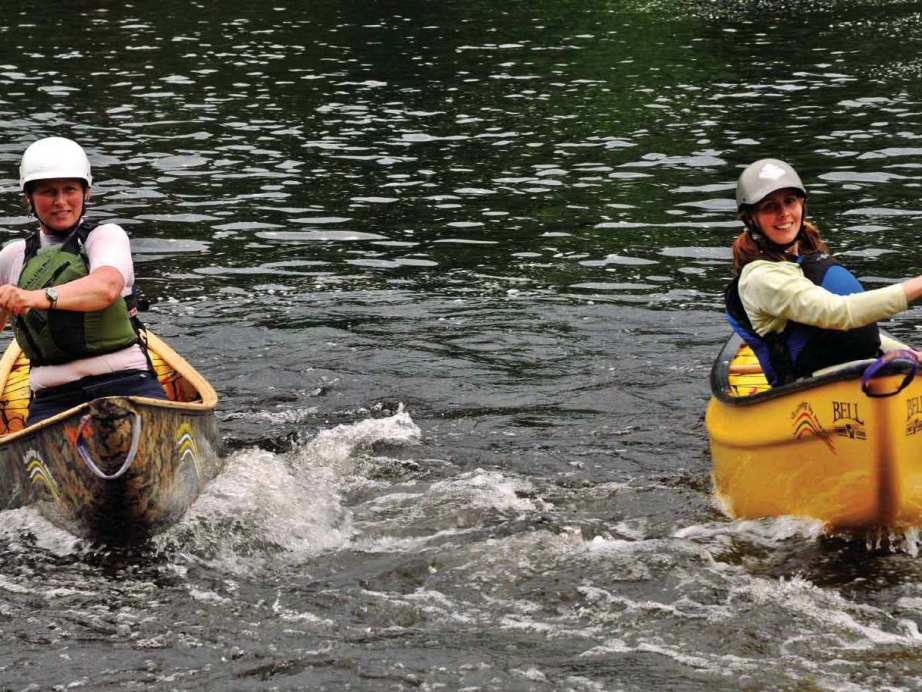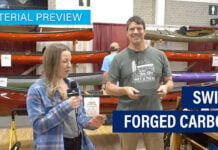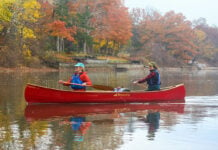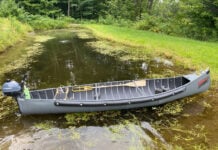A comparison and review of the Esquif Spark and Bell Ocoee whitewater open canoes from Rapid magazine.
At first glance , these two boats appear as disparate as apples and oranges. The hull materials are different and everything about the shapes seems to be from separate fruit baskets altogether. And yet many prospective OC buyers agonize over this choice: Bell Ocoee or Esquif Spark? Let’s examine some of the facts and debunk some of the myths surrounding these two top contenders.
“The Spark is so much lighter.”
Sorry, partner. The Spark may be an effortless river darter but it also comes stock with wood gunwales. Make the comparison meaningful with comparable wood trim on the Ocoee and it weighs just 43 pounds fully outfitted. The Spark comes in at 42 pounds outfitted. The difference is the weight of 17 oz (a half-litre) of water—one small wave splashing in for the ride.
“The Ocoee is so much tougher.”
The outer layer of the Ocoee’s hull is made from the same material as plastic plumbing pipe and is not as prone to crushing from rock collisions as the Spark’s Royalite material, but Royalite does toughen with age and will gain durability. Treat your Spark hull with respect and it will last for years.
“The Spark doesn’t surf well.”
With more rounded chines and bottom, less secondary stability and a long, thin stern, the Spark is a somewhat less stable surfing platform than the flatter-hulled, hard-chined Ocoee. Although the learning curve is steeper for Spark surfing, it’s pretty easy to get it on a wave.
“The Ocoee wasn’t meant for racing.”
Both boats were designed by accomplished slalom paddlers. The Ocoee’s designer, the late Frankie Hubbard, was a top-level competitive racer, and of course, John Kazimierczyk (who now has over 100 slalom medals in his sock drawer) adapted his Ignitor solo race boat to create the Spark. Hubbard and Kaz even used to race together.
“The Spark is faster.”
With its narrower footprint and flatter shallow arch hull, the Spark is faster than an Ocoee. However, except in the hands of exceptional paddlers for whom wave-blocking and finding the perfect line every time is instinctive, the Spark is also wetter. The Ocoee is flared outward from the waterline to the gunwales; the Spark flares inward, a trait that lends itself to the attack style and vertical forward stroke used in slalom racing…and to water forever rinsing your knees. For most paddlers, the Spark’s natural speed advantage slips away as it gets heavier with every wave. Both boats also show a performance bias for lighter paddlers, as heavier paddlers cause the bows to push water with predictable effects on speed.
“The outfitting always falls out of the Spark.”
Absolutely true—if you don’t install the anchors with Stabond glue and pre-clean the gluing surfaces with MEK cleaner. Vinyl glue is almost useless except in the very short term, and it’s a waste of good outfitting anchors. This is because the inner layer of the Spark is ABS, not vinyl. Use the right adhesive and your outfitting will stay put.
Whether it’s apples and oranges or an Ocoee and Spark, the best fruit—like the best canoe—is the one that suits your tastes. If you are determined to stand on the slalom podium, to devote yourself to the pursuit of competitive excellence, the Spark is your boat. If you want to practice in slalom gates, race for pure fun, run wild rivers with rocks and drops, play in steep creeks and do it all in smug dryness, then the more versatile, Ocoee is the boat to fall in love with.
This article originally appeared in Rapid, Summer/Fall 2010. Download our free iPad/iPhone/iPod Touch App or Android App or read it here.








